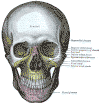Nose Anatomy and Function
The nose is complex, both in form and function. It consists of skin, bone, cartilage, blood vessels, and nerves. It houses our sense of smell, takes an important part in breathing, and sits there in the middle of the face where no one can miss it.
Although I realize that if you are reading this website, you may be more concerned with the appearance rather than the anatomy of your nose, but the loss of functions is a sad reality for many people. From difficulty breathing to the loss of the sense of smell to sinus headaches to postnasal drip, there is more to rhinoplasty and the nose than just beauty.
Your nose anatomy can be divided into two parts. The external part is the structure that sticks forward from your face. The nasal cavity extends back from the outer nose into your head and connects with the sinuses, which are hollow areas under your forehead, cheekbones, and deeper into the skull. Both the external nose and the nasal cavity are divided vertically by a wall called the nasal septum. This is the wall between your two nostrils and it extends back behind the nose into the nasal cavity.
For information about anatomy of the face and other types of facial surgery, including pages about facelift recovery and facelift before and after photos, visit All About Facial Rejuvenation.
Nasal Cavity Anatomy
Your sense of smell—olfaction—is a complex system of changing scents into nerve signals that your brain then processes to receive important information from the outside the body. You don't even realize how often you use your sense of smell. Is that food good or is it is rancid? Was that odor roses or dung? You may think the sense of smell is unimportant and that you can easily do without it, but it plays a major role in how we perceive the flavor of foods and even in how we pick a potential mate. Otherwise, why would we be buying all that perfume and cologne?
The process of olfaction begins with inhaling. Air is pulled through the nostrils and into the nasal cavity. The top side of your nasal cavity is directly under your brain and is separated from it by a very thin wall of bone and mucus membrane. That membrane is the location for a small area that contains millions of olfactory receptor nerves. These can differentiate between thousands of individual smells. Some people have an excellent sense of smell, but others suffer from anosmia, a loss of the sense of smell, which can impair their quality of life. Others suffer from phantom nasty smells, the olfactory version of hallucinations.
 |
 |
The nasal cavity is also the topmost part of your respiratory system. At the back, where your soft palate ends, it is open to your throat. The nose is an air filter and conditioner for your lungs. The hairs in your nose keep out dust and microscopic particles. The anatomy of your nasal cavity has shelves and folds that warm the air and add moisture to it before it reaches your lungs, which makes breathing much more comfortable. These shelves are called the turbinates.
 |
The sinuses, which are lined with mucous membrane (also called mucosa), also play a role in humidifying and warming air as you breathe in. These empty spaces also reduce the weight of the skull and facial bones and increase the resonance of the voice.
Your nasal cavity is connected to your inner ears. The Eustachian tubes run down from your inner ear into your nasal cavity at the top of your throat, which is why a cold or bacterial infection can seem to hit you in the ears, nose, and throat at once or in sequence. The Eustachian tubes are there to equalize pressure between your inner ears and the outside.
External Nose Anatomy
You need to understand your nose anatomy if you are considering making changes to the external parts of your nose. The external nose is supported by this underlying nasal structure. Changing one can have an effect on the other in some way. Rhinoplasty complications can affect your breathing, your sense of smell, and not just your looks.
The external nose anatomy is basically a three-sided pyramid. The framework of the external nose is made up of bones and cartilages. This is covered by skin and lined with mucosa. The ridge leading down from the forehead to the tip of the nose is called the bridge or dorsum. At the top, it is made of bone and skin, while the bottom half is cartilage and skin. The cartilage of the tip of the nose and nostrils is actually in five pieces that are connected by membranes. The septum that separates the two nostrils consists of cartilage covered by membrane.
 |
 |
The skin of the dorsum and sides of the nose is thin, but is thicker over the tip and nostrils. This skin also has a more sweat and oil glands than skin on other parts of the face.
And you just thought your nose just sat there on your face!

